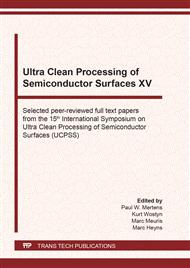p.3
p.9
p.17
p.23
p.29
p.34
p.41
p.49
Characterization and Removal of Metallic Contamination in H2O and H2O2 Using Single Particle Inductively Coupled Plasma Mass Spectrometry
Abstract:
Metallic contamination is a major challenge in multiple semiconductor processes, including photolithography and wet etch and cleans (WEC). Though there are several contributors to metallic contamination, significant efforts have focused on improving the incoming quality of process chemicals, especially commodity chemicals. Another key contributor to on-wafer metallic contamination is water (H2O), which is used to dilute most aqueous chemicals. Single Particle Inductively Coupled Plasma Mass Spectroscopy (SP-ICP-MS), a technique relying on time-based resolution of pulses generated during a standard ICP-MS analysis, is used to aid the understanding of metal particle contamination in water and process chemicals.In this paper, we studied water and 30% Hydrogen Peroxide (H2O2), two of the most widely used chemicals across all WEC processes. We used a high purity grade of 30% H2O2, further diluted to a typical use concentration (5% by volume) using two grades of Deionized Water (unfiltered and filtered) where the concentration of metallic particles was the key variable. The metals studied included Iron (Fe), Chromium (Cr), Zinc (Zn), Titanium (Ti), Nickel (Ni) and Aluminum (Al), representing some of the most commonly observed metallic contaminants in H2O2 and water. After analyzing the distribution of contaminants in the chemicals, filters were introduced into the system to observe the impact of filtration on metal removal. The importance of filtration on the overall quality of the diluted process chemical was demonstrated by using a Polysulfone (PS) membrane to filter the lower grade Deionized Water (DIW).
Info:
Periodical:
Pages:
9-16
Citation:
Online since:
February 2021
Authors:
Price:
Сopyright:
© 2021 Trans Tech Publications Ltd. All Rights Reserved
Share:
Citation:


